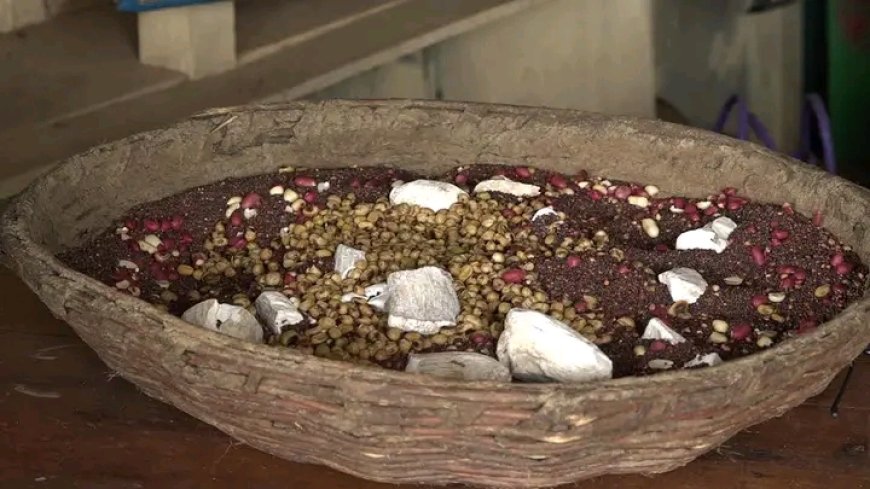From nursing to farming-Diabetic condition triggers profitable finger millet farming

Nairobi,
Saturday, August 12, 2023
KNA by William Inganga
Nurses are fond of referring to their profession as “a calling.” Included in this lot is, Margaret Kubende, who retired from her nursing job in 2017, having put in 36 years of service as a community nurse.
In as much as nursing the physically indisposed is a noble cause, Kubende recognizes that she has another occupation that runs a close second to nursing. Her biography is reminiscent of a movie, where the curtain to part one has been drawn. She ushers part two by saying, “I am a farmer.” She specifies, “A wimbi farmer especially.”
Her diabetic condition triggered a change in her diet. From that time henceforth, “My main food was to be wimbi,” she says.
“I thought I had better try growing it myself rather than buying,” she says. Consequently, for over ten years, she’s been farming finger millet.
At 66 years of age, she prides in looking younger than her peers. “Can you compare me with someone who eats maize?” She asks. She immensely attributes her glittering appearance to her diet composed of millet products.
The number of her hired labourers, both men and women, varies depending on the volume of work. During harvest, knives or sickles in hand, the workers move within close proximity to each other, clipping off the panicles of the finger millet.
Kubende has noticed that many farmers in her region steer off millet farming due to the notion that it is labour-intensive.
“During the last season I was selling 2kg of millet at Sh350,” she recalls. “I have to add value by cleaning it thoroughly so that when you buy my wimbi, you just take it to the miller.”
Her price is Sh. 50 above that of other traders at the closest market to her stall located at Ejinja, along the Mumias, Busia Road. The lowest she’s sold her 2kg tin of millet is sh. 250.
She strives to ensure that her millets maintain an edge over others brought in from nearby Uganda. She ensures that sand particles and other matter are eliminated lest they soil her products.
The price of maize sometimes drops as low as Sh. 30 per 2kg tin. Kubende is convinced that the returns from millet are more attractive than those from maize. She estimates that the lowest amount she could earn from a sack of millet is Sh. 12,000.
At her stall is a variety of millet beckoning customers. A popular brand here awaits mothers who are almost beginning to introduce complimentary feeding to their babies after six continuous months of exclusive breastfeeding.
The millet grains have an assortment of dried cassava chips, soya beans, and groundnuts. These would be milled together to produce compound flour. Two kilograms of this kind of flour costs Sh. 500.
Kubende says her customers keep returning to her stall for more millet. “I receive orders from as far away as Mombasa,” she says.
Kubende remembers that in 2006, the Kenya Agricultural and Livestock Research Organization (KALRO) got in touch with her. This was through a leading finger millet breeder, Dr. Chrispus Oduori, who provided her with the U-15 (also known as Maridadi) finger millet seeds and fertilizer for some trials on her farm.
“I worked with KALRO for three years and thereafter went solo,” she says. Since then, she’s not ceased practicing her second profession that compliments her efforts to spur good health around Ikulu-Mwoyo area in Matungu Sub-county and beyond.
Dr. Oduori has developed nine new varieties of finger millet that are ideal for a wide range of agro-ecological regions. He considers Kubende to be one of the most successful finger millet farmers in western Kenya.
The personal parcel of land on which Kubende grows the millet is one-and-a-half acres. However, she scouts around for other idle tracts within her neighborhood and hires them specifically for finger millet cultivation. The rented fields may total five acres on average during every rainy season, which runs from March to June.
Even if the rains prove erratic due to the uncertainties contributed by the effects of climate change, Kubende maintains her confidence that her harvest won’t be completely wiped out.
The International Maize and Wheat Improvement Centre Partnerships and Seed Systems Lead under the dryland crops program, Dr. Chris Ojiewo, is cognizant of the fact that KALRO is at the heartbeat of developing new varieties of drought-tolerant maize.
“Both pearl and finger millet have their own natural tolerance to drought,” he says. He encourages farmers, “to diversify their crop portfolio to include millet without abandoning maize, so that in case of episodes of a bad year then they don’t lose everything.”
According to the 2023 Kenya National Bureau of Statistics (KNBS) Economic Survey, “Most of the key agriculture sub-sectors recorded declined performance resulting to a contraction of 1.6 per cent in the sector’s gross value added in the year 2022. Drought in most parts of the country severely affected agricultural production. Maize production decreased from 36.7 million bags in 2021 to 34.3 million bags in 2022.”
The report further states that rainfall distribution, was generally poor with most parts of the country receiving below average amounts of rainfall during both long and short rain seasons of March-April-May (MAM) and October-November-December (OND) respectively in the year under review (2022).
Since millets are climate-smart, food, nutrition and income securities could arise from them, Dr. Ojiewo believes, if the country’s cropping and agrifood systems are diversified.
“I am the one who sells the seeds to the farmers here,” Kubende, who cultivates her millet in lines, says. “This makes weeding easier. “I don’t like overcrowding my millet with maize, or even beans.”
John Wesonga, was attracted to finger millet farming having observed Kubende’s successes. “Margaret is the one who convinced me to venture into millet farming,” he says. “I’m firmly into it and I don’t see myself stopping.”
Wesonga’s farm is five acres. He’s reserved one for millet. He grows it for commercial purposes and family consumption.
During the last harvesting season, his crop took three-and-a-half months to mature. “I reaped six sacks,” he says. “I sold three at sh. 12, 000 each.”
Wesonga used to work at a sugar company in western Kenya. He delved into millet farming after he lost his job. He doesn’t brood over the loss of his job.
So marketable is millet that, “Customers book it even before it is harvested,” he says. Whereas other farmers around him concentrate on maize, his earnings enable him to purchase maize for his family.
Kubende decries the shortage of millet in her area. Many a time, she outsources from other farmers whom she trusts. “I don’t have enough,” she says. “I have an order of 30 2kg tins and on hand is only five.”
Visitation periods by in-laws and funerals present an opportunity for her millets to run out very fast. Millet ugali and porridge are highly priced during such occasions.
Dr. Ojiewo recommends a heightened awareness creation regarding the positive aspects of millets, taking advantage of 2023 as the international year of millets.
If there is increased production and consumption of millets, which include sorghum, “We will revolutionize our agronomics and agrifood systems in Kenya,” Dr. Ojiewo says.
In terms of nutritional value Dr. Oduori says, “Nothing can compare with finger millet because it is highly nutritious in terms of protein, carbohydrate and mineral content.”
He stresses that minerals are the selling point for finger millet. “There is no other cereal that has the mineral profile like that of finger millet,” he says.
Just like Dr. Ojiewo, Dr. Oduori wouldn’t like to advocate that farmers do away with maize but rather encourage farmers to have the two crops coexist on their farms. The crops would play supplementary roles.
For nutrition purposes, “Finger millet would be the cereal to go for,” Dr. Oduori says. “There has never been a time when the cost of finger millet has been less than that of maize and sorghum,” Dr Oduori says. “In terms of market pricing, it is still the most valued cereal that we have.”
Courtesy ; K. N. A
What's Your Reaction?



































































































































































































































































































